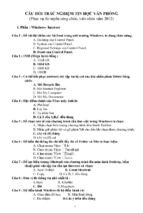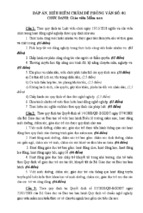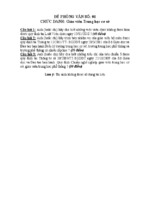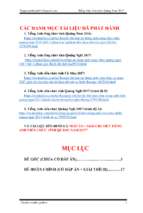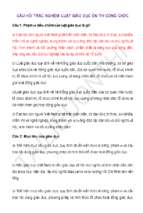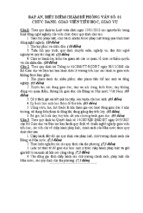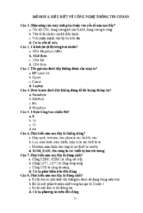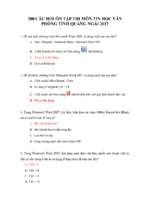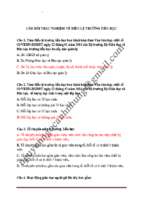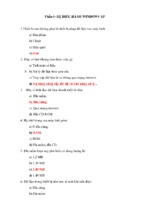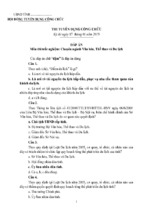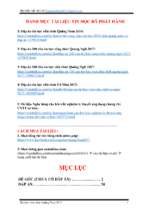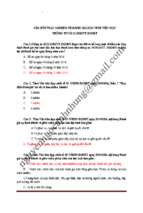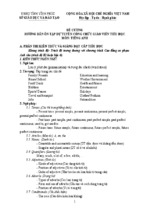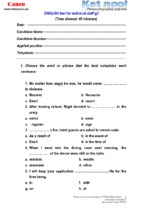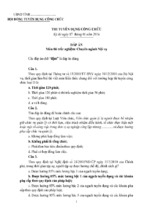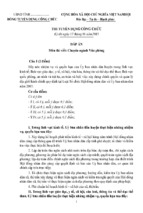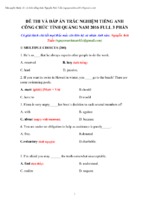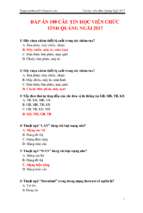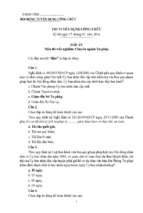ĐÁP ÁN CÂU HỎI TIẾNG ANH PHẦN ĐỌC HIỂU THI CÔNG
CHỨC TỈNH
•
ĐÁP ÁN CÂU HỎI TIẾNG ANH THI CÔNG CHỨC TỈNH
(PHẦN ĐỌC HIỂU)
C1.
All spiders spin webs. That's because webs help spiders. Webs help
spiders do
three things. Webs help spiders hold eggs. Webs help spiders hide. And
webs help
spiders catch food. Webs help spiders hold eggs. Many spiders like to
lay their
eggs in their webs. The webs help keep the eggs together. Webs help
spiders keep
their eggs safe. Webs help spiders hide. Most spiders are dark. They are
brown,
grey, or black. But spider webs are light. They are white and cloudy.
When spiders
hide in their webs, they are harder to see. Webs help spiders catch food.
Spider
webs are sticky. When a bug flies into the web, it gets stuck. It moves
around. It
tries to get out. But it can't. It is trapped! Spiders can tell that the bug is
trapped.
That's because spiders feel the web move. And the spider is hungry. The
spider
goes to get the bug. As you can see, webs help spiders hold eggs. Webs
help
spiders hide. And webs help spiders catch food. Without webs, spiders
would not
be able to live like they do. Spiders need their webs to survive.
Questions
1) This passage is mostly about
A. spider colors B. spider webs
C. spider eggs D. spider foods
2) Spider webs help spiders:
I. hold egg II. catch food III. find water
A. I only B. I and II only
C. I, II, and III D. II and III
3) As used in paragraph 4, the word trapped most nearly means
A. stuck B. hidden
C. eaten D. catch
•
•
4) How can spiders tell when something is trapped in their web?
A. They hear it. B. They smell it.
C. They feel it. D. They taste it
5) As used in the last sentence of the passage, the word survive means to
stay
A. alive B. hidden
C. caught D. sleep
Bài dịch:
Tất cả loài nhện đều dệt mạng nhện cho nó. Đó là bởi vì mạng nhện giúp
nhện làm
ba việc, giúp nhện giữ trứng, giúp nhện ẩn kín, và giúp nhện bắt mồi.
mạng nhện
giúp nhện giữ trứng, nhiều loài nhện thích để đẻ trứng trong mạng của
nó và lưới
giúp giữ trứng lại với nhau. Nó giúp nhện giữ trứng của họ an toàn.
Mạng nhện
còn giúp nhện ẩn đi. Hầu hết các loài nhện đều có màu, Chúng có màu
nâu, xám
hoặc đen. Nhưng mạng nhện lại sáng hơn, nó có màu trắng hoặc trông
như mây.
Khi nhện ẩn trong mạng của nó, loài khác rất khó nhìn thấy. mạng nhện
giúp nhện
bắt mồi vì nó rất dính. Khi một con mồi bay vào, nó sẽ bị mắc kẹt trong
đó. Nó di
chuyển xung quanh và cố gắng để thoát ra ngoài. Nhưng nó không thể.
Nó bị mắc
kẹt! Nhện có thể vui mừng nhận ra con mồi đã bị mắc kẹt, đó là bởi vì
nhện cảm
nhận được khi di chuyển trên mạng nhện, và khi nó đói, Nó sẽ đi để săn
được
những con mồi khác. Như bạn có thể thấy, mạng nhện giúp giữ trứng.
Webs giúp
nhện ẩn. Và súc giúp nhện bắt mồi. Nếu không có mạng nhện, nhện sẽ
không thể
sống được. Loài nhện luôn cần mạng nhện để tồn tại.
C2.
Most human beings are awake during the day and sleep all night. Owls
live the
opposite way. Owls are nocturnal. This means that they sleep all day and
stay
awake at night. Because owls are nocturnal, this means they must eat at
night. But
finding food in the dark is difficult. To help them, they have special eyes
and ears.
Owls have very large eyes. These eyes absorb more light than normal.
Since there
is little light during the night, it is helpful to be able to absorb more of it.
This
helps owls find food in the dark. Owls also have very good hearing.
Even when
•
•
owls are in the trees, they can hear small animals moving in the grass
below. This
helps owls catch their prey even when it is very dark. Like owls, mice
are also
nocturnal animals. Mice have an excellent sense of smell. This helps
them find
food in the dark. Being nocturnal helps mice to hide from the many
different
animals that want to eat them. Most of the birds, snakes, and lizards that
like to eat
mice sleep at night—except, of course, owls! Some animals are
nocturnal. This
means they are active at night. The owl and the mouse are good
examples of
nocturnal animals that use their senses to find food in the dark.
Questions
1) In paragraph 1, we learn that "Owls are nocturnal." The word diurnal
is the
opposite of the word nocturnal. Using information in the passage as a
guide, we
can understand that an animal that is diurnal
A. sleeps at night and is awake during the day
B. hunts during the day and is awake at night
C. sleeps every other night and is awake during the day
D. hunts during the day and night
2) Based on information in paragraph 2, it can be understood that an
animal with
small eyes
A. must be diurnal B. has trouble seeing in the dark
C. can see very well at night D. is likely to be eaten by an owl
3) According to the passage, owls can find food in the dark using their
sense of
I. sight II. Sound III. smell
A. l only B. I and II only
C. II and III only D. I, II, and III
4) In paragraph 3 the author writes, "This helps owls catch their prey
even when it
is very dark." Based on its use in the passage, we can understand that
prey is
A. a noise that an animal makes during the night
B. a small animal such as a pet dog or cat
C. an animal that is hunted by other animals
•
•
D. an animals that hunts other animals
5) Based on information in the final paragraph, it can be understood that
mice sleep
during the day in order to
A. find food that other animals can not B. keep themselves safe
C. store energy for night time activities D. release stress
6) Based on information in the final paragraph, it can be understood that
A. owls hunt mice B. mice can hide from owls
C. mice and owls both hide from birds, snakes, and lizards
D. birds and snakes often hunt lizards
7) If added to the end of this passage, which of the following
conclusions would fit
best?
A. The owl is a nocturnal animal. This means it is active at night. The
owl's
excellent sense of sight and sound enable it to find food in the dark.
B. Mice are nocturnal animals. This means they are active at night.
Similar to the
owl, mice use their excellent sense of smell to find food in the dark.
C. Both mice and owls are nocturnal. This means they are active at
night. Because
these animals are active at night, they must sleep during the day. This
makes them
especially vulnerable to attack from diurnal animals.
D. Some animals are nocturnal. This means they are active at night. The
owl
and the mouse are good examples of nocturnal animals that use their
senses to
find food in the dark.
Bài dịch: Hầu hết con người tỉnh táo vào ban ngày và ngủ ban đêm thì
loài Cú
sống theo cách ngược lại. Cú là loài ăn đêm. Điều này có nghĩa rằng nó
ngủ cả
ngày và lại tỉnh táo vào ban đêm. Vì cú là loài ăn đêm, nên nó phải kiếm
ăn vào
buổi tối. Nhưng việc tìm kiếm thức ăn trong bóng tối là khó khăn. Để
giúp cho
việc đó, Cú có đôi mắt và tai rất đặc biệt. Cú có mắt rất lớn, những đôi
mắt hấp thụ
ánh sáng nhiều hơn bình thường, kể cả rất ít ánh sáng trong đêm, nó là
hữu ích.
Điều này giúp con cú tìm kiếm thức ăn trong bóng tối. Cú cũng có thính
giác rất
tốt, Ngay cả khi đang trong cây, nó cũng có thể nghe thấy những con vật
nhỏ di
chuyển trên thảm cỏ bên dưới. Điều này giúp con cú bắt mồi ngay cả khi
trời rất
tối. Giống như cú, Chuột cũng là loài động vật ăn đêm. Chuột có một
cảm giác
tuyệt vời về mùi vị. Điều này giúp chúng tìm thức ăn trong bóng tối. Ăn
đêm cũng
•
•
giúp chuột trốn được nhiều loài động vật muốn ăn chúng như các loài
chim, rắn và
thằn lằn, chúng thích ăn những con chuột ngủ vào ban đêm, tất nhiên trừ
cú! Một
số động vật hoạt động về đêm. Điều này có nghĩa là chúng thường
xuyên hoạt
động vào buổi tối. Con cú và chuột là những ví dụ điển hình cho các loài
vật về sử
dụng giác quan của chúng để tìm kiếm thức ăn trong bóng tối.
C3.
When we are young, we learn that tigers and sharks are dangerous
animals. We
might be scared of them because they are big and powerful. As we get
older;
however, we learn that sometimes the most dangerous animals are also
the smallest
animals. In fact, the animal that kills the most people every year is one
that you
have probably killed yourself many times: the mosquito. While it may
seem that all
mosquitoes are biters, this is not actually the case. Male mosquitoes eat
plant
nectar. On the other hand, female mosquitoes feed on animal blood.
They need this
blood to live and produce eggs. When a female mosquito bites a human
being, it
transmits a small amount of saliva into the blood. This saliva may or
may not
contain a deadly disease. The result of the bite can be as minor as an
itchy bump or
as serious as death. Because a mosquito can bite many people in the
course of its
life, it can carry diseases from one person to another very easily. Two of
the most
deadly diseases carried by mosquitoes are malaria and yellow fever.
Mosquitoes
have many natural enemies like bats, birds, dragonflies, and certain
kinds of fish.
Bringing more of these animals into places where mosquitoes live might
help to
cut down the amount of mosquitoes in that area. This is a natural
solution, but it
does not always work very well. Mosquitoes can also be killed with
poisons or
sprays. Even though these sprays kill mosquitoes, they may also harm
other plants
or animals.
Questions
1) According to the author, some people are more afraid of tigers and
sharks than
mosquitoes because tigers and sharks
A. kill more people than mosquitoes B. are big and powerful
C. are found all over the world D. have no natural enemies
2) Based on the information in paragraph 2, we can understand that
•
•
I. male mosquitoes and female mosquitoes have different eating habits
II. male mosquitoes are harmless to humans
III. female mosquitoes are responsible for transmitting diseases to
humans
A. I only B. I and II only
C. II and III only D. I, II, and III
3) In paragraph 2 the author writes, "This saliva may or may not contain
a deadly
disease." The purpose of this statement is to
A. oppose a previous argument B. question an upcoming conclusion
C. confirm a hypothesis D. support a later statement
4) As used in paragraph 2, minor most nearly means
A. insignificant B. deadly
C. frustrating D. dangerous
5) Based on information in paragraph 3, it can be understood that if you
get sick
with malaria or yellow fever, your chances of survival are
A. terrible B. mediocre
C. good D. excellent
6) It can be understood that the introduction of dragonflies might
reduce the
number of flies in a given area because dragonflies
A. work together with mosquitoes B. kill mosquitoes
C. cannot be killed by poisons or sprays D. attract bats
7) Which of the following best summarizes the information in paragraph
4?
A. Mosquito nets provide adequate protection from deadly mosquitoes.
B. Poisons and sprays provide adequate protection from deadly
mosquitoes.
C. The introduction of the mosquito's natural enemies provides adequate
protection
from deadly mosquitoes.
D. There is no perfect solution to the mosquito problem.
•
•
8) Which of the following words best describes the author's
overall attitude
towards the prospect of solving the mosquito problem?
A. despondent, meaning hopeless or dejected
B. exasperated, meaning extremely irritated or annoyed
C. equivocal, meaning doubtful or uncertain
D. optimistic, meaning hopeful or taking a favorable view
Bài dịch: Khi còn nhỏ, chúng ta biết rằng những con hổ và cá mập là
loài động vật
nguy hiểm. chúng ta có thể sợ hãi bởi vì nó rất lớn và mạnh mẽ. Tuy
nhiên khi về
già; chúng ta biết rằng đôi khi các loài động vật nguy hiểm nhất cũng là
những sinh
vật nhỏ nhất. Trong thực tế, con vật mà giết chết nhiều người mỗi năm là
một trong
những con vật bạn đã có thể đã giết chết nhiều lần như muỗi. Trong khi
có vẻ tất cả
loài muỗi đều như nhau, nhưng không phải vậy. muỗi đực ăn mật hoa
thực vật.
Mặt khác, muỗi cái ăn máu động vật. chúng cần máu này để sống và sản
xuất
trứng. Khi một con muỗi cái cắn một con người, nó truyền tải một lượng
nhỏ nước
bọt vào máu. nước bọt này có thể hoặc không thể chứa một căn bệnh
chết người
nhưng kết quả của vết cắn có thể là một vết sưng ngứa hoặc nghiêm
trọng là tử
vong. Bởi vì một con muỗi có thể cắn nhiều người trong cuộc sống của
nó, nó có
thể mang bệnh từ người này sang người khác rất dễ dàng. Hai trong số
các căn
bệnh chết người nhất thực hiện bởi muỗi là sốt rét và sốt vàng da. Muỗi
có nhiều
kẻ thù tự nhiên như con dơi, chim, chuồn chuồn, và một số loại cá. Đưa
nhiều các
động vật vào nơi muỗi sinh sống có thể giúp cắt giảm số lượng muỗi
trong khu vực
đó. Đây là một giải pháp tự nhiên, nhưng nó không hẳn là phương pháp
tối ưu.
Muỗi cũng có thể bị giết với chất độc hoặc thuốc xịt. Mặc dù các thuốc
xịt diệt
muỗi cũng có thể gây tổn hại cho thực vật hoặc động vật khác.
C4.
Rainforests circle the globe for twenty degrees of latitude on both sides
of the
equator. In that relatively narrow band of the planet, more than half of all
the
species of plants and animals in the world make their home. Several
hundred
different varieties of trees may grow in a single acre, and just one of
those trees
may be the habitat for more than ten thousand kinds of spiders, ants, and
other
•
•
insects. More species of amphibians, birds, insects, mammals, and
reptiles live in
rainforests than anywhere else on earth. Unfortunately, half of
the world’s
rainforests have already been destroyed, and at the current rate, another
25 percent
will be lost by the year 2030. Scientists estimate that as many as fifty
million acres
are destroyed annually. In other words, every sixty seconds, one hundred
acres of
rainforest is being cleared. By the time you finish reading this
passage, two
hundred acres will have been destroyed! When this happens, constant
rains erode
the former forest floor, the thin layer of soil no longer supports plant life,
and the
ecology of the region is altered forever. Thousands of species of plants
and animals
are condemned to extinction and since we aren’t able to predict the
ramifications of
this loss to a delicate global ecology, we don’t know what we may be
doing to the
future of the human species as well.
1. What is the point of view that the author expresses in this passage?
A. The author believes that the rainforest will survive
B. The author believes that preserving the rainforest is important to
global ecology
C. The author believes that he can predict the future of global econogy
D. The author believes that the extinction of species is a natural pprocess
2. According to the passage, more than half of all the species of plants
and
animals………
A. Live in twenty rainforests
B. Live in several hendred different varieties of trees
C. Live in a forty-degree band of latitude
D. Live in areas where the rainforest has been cleared
3. How many of the words rainfrorests are projeced to be destroyed by
the
year 2000 if the current rate continues?
A. All of them will be gone
B. Haft of them will be gone
C. One-quarters of them will be gone
D. Three-quarters of them will be gone
4. The word “this” in line 12 refers to…………
A. The destruction of the acres
B. The reading of the passage
C. The erosion of the forest floor
D. The constant rain
5. What will not happen if the rainforest continuess to be cleared?
A. The land will be eroded by the rains
•
•
B. Many species of plants and animals that depend on the rainforest will
become extinct
C. The future of the human species may be changed
D. The rainforest will glow, but at a much slower rate
Bài dịch: Rừng mưa nhiệt đới bao quanh các nơi trên thế giới trong hai
mươi vĩ độ
trên cả hai bên của đường xích đạo. Trong đó có các vùng tương đối hẹp
của hành
tinh, hơn một nửa trong số tất cả các loài thực vật và động vật trên thế
giới làm nên
hệ sinh thái nơi đây. Hàng trăm giống khác nhau của cây có thể phát
triển trong
một vùng, và một trong những cây đó có thể là môi trường sống cho hơn
mười
nghìn loại nhện, kiến, và côn trùng khác. Nhiều loài động vật lưỡng cư,
chim, côn
trùng, động vật có vú, và các loài bò sát sống trong rừng mưa nhiệt đới
nhiều hơn
bất cứ nơi nào khác trên trái đất. Thật không may, một nửa của rừng
nhiệt đới trên
thế giới đã bị phá hủy, và nếu cứ tiếp diễn, 25% sẽ bị mất vào năm 2030.
Các nhà
khoa học ước tính rằng có đến năm mươi triệu mẫu thực vật bị phá hủy
mỗi năm.
Nói cách khác, mỗi phút một trăm hecta rừng nhiệt đới đang bị phá hủy.
Bởi thời
gian bạn đọc xong đoạn này, hai trăm mẫu đất sẽ bị hủy diệt! Khi điều
này xảy ra,
mưa liên tục làm xói mòn tầng rừng trước đây, lớp đất mỏng không còn
hỗ trợ đời
sống thực vật và hệ sinh thái của khu vực này sẽ bị thay đổi mãi mãi.
Hàng ngàn
loài thực vật và động vật bị kết án tuyệt chủng và vì chúng ta không thể
dự đoán
được hậu quả của sự mất mát này đến một hệ sinh thái toàn cầu, chúng
ta không
biết những gì mình có thể làm cho tương lai của loài người tốt đẹp hơn.
C5.
Should women find their happiness inside or outside the home? In the
United
States people used to believe the saying, “A woman’s place is in the
home.” But
now both women and society are changing. More than fifty percent of
American
women continue their work even after they are married. What has
brought about
these changes? What is happening to the American family today? Up
until the
1950’s a typical American woman got married in her early 20’s. In those
days she
quit her job and became a mother. “A woman’s place is in the home”
was a
popular saying. Most women felt that taking care of their home and
family was
•
•
ĐÁP ÁN CÂU HỎI TIẾNG ANH THI CÔNG CHỨC TỈNH QUẢNG
NAM
(PHẦN ĐỌC HIỂU)
C1.
All spiders spin webs. That's because webs help spiders. Webs help
spiders do
three things. Webs help spiders hold eggs. Webs help spiders hide. And
webs help
spiders catch food. Webs help spiders hold eggs. Many spiders like to
lay their
eggs in their webs. The webs help keep the eggs together. Webs help
spiders keep
their eggs safe. Webs help spiders hide. Most spiders are dark. They are
brown,
grey, or black. But spider webs are light. They are white and cloudy.
When spiders
hide in their webs, they are harder to see. Webs help spiders catch food.
Spider
webs are sticky. When a bug flies into the web, it gets stuck. It moves
around. It
tries to get out. But it can't. It is trapped! Spiders can tell that the bug is
trapped.
That's because spiders feel the web move. And the spider is hungry. The
spider
goes to get the bug. As you can see, webs help spiders hold eggs. Webs
help
spiders hide. And webs help spiders catch food. Without webs, spiders
would not
be able to live like they do. Spiders need their webs to survive.
Questions
1) This passage is mostly about
A. spider colors B. spider webs
C. spider eggs D. spider foods
2) Spider webs help spiders:
I. hold egg II. catch food III. find water
A. I only B. I and II only
C. I, II, and III D. II and III
3) As used in paragraph 4, the word trapped most nearly means
A. stuck B. hidden
C. eaten D. catch
•
•
4) How can spiders tell when something is trapped in their web?
A. They hear it. B. They smell it.
C. They feel it. D. They taste it
5) As used in the last sentence of the passage, the word survive means to
stay
A. alive B. hidden
C. caught D. sleep
Bài dịch:
Tất cả loài nhện đều dệt mạng nhện cho nó. Đó là bởi vì mạng nhện giúp
nhện làm
ba việc, giúp nhện giữ trứng, giúp nhện ẩn kín, và giúp nhện bắt mồi.
mạng nhện
giúp nhện giữ trứng, nhiều loài nhện thích để đẻ trứng trong mạng của
nó và lưới
giúp giữ trứng lại với nhau. Nó giúp nhện giữ trứng của họ an toàn.
Mạng nhện
còn giúp nhện ẩn đi. Hầu hết các loài nhện đều có màu, Chúng có màu
nâu, xám
- Xem thêm -

